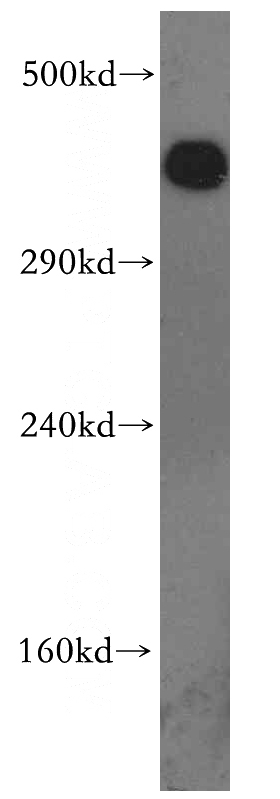-
Product Name
DNA-PKcs antibody
- Documents
-
Description
DNA-PKcs Rabbit Polyclonal antibody. Positive WB detected in HeLa cells, MCF7 cells. Observed molecular weight by Western-blot: 350-460 kDa
-
Tested applications
ELISA, WB
-
Species reactivity
Human, Mouse; other species not tested.
-
Alternative names
DNA PK catalytic subunit antibody; DNAPK antibody; DNA-PKcs antibody; DNPK1 antibody; HYRC antibody; HYRC1 antibody; p350 antibody; p460 antibody; PRKDC antibody; XRCC7 antibody
-
Isotype
Rabbit IgG
-
Preparation
This antibody was obtained by immunization of Peptide (Accession Number: NM_006904). Purification method: Antigen affinity purified.
-
Clonality
Polyclonal
-
Formulation
PBS with 0.02% sodium azide and 50% glycerol pH 7.3.
-
Storage instructions
Store at -20℃. DO NOT ALIQUOT
-
Applications
Recommended Dilution:
WB: 1:500-1:5000
-
Validations

HeLa cells were subjected to SDS PAGE followed by western blot with Catalog No:109957(PRKDC antibody) at dilution of 1:300
-
Background
PRKDC, also named as HYRC, HYRC1, DNPK1 and p460, belongs to the PI3/PI4-kinase family. PRKDC is a serine/threonine-protein kinase that acts as a molecular sensor for DNA damage. Involved in DNA nonhomologous end joining (NHEJ), PRKDC is required for double-strand break (DSB) repair and V(D)J recombination. PRKDC must be bound to DNA to express its catalytic properties. It promotes processing of hairpin DNA structures in V(D)J recombination by activation of the hairpin endonuclease artemis (DCLRE1C). It is required to protect and align broken ends of DNA. PRKDC may also act as a scaffold protein to aid the localization of DNA repair proteins to the site of damage. It is found at the ends of chromosomes, suggesting a further role in the maintenance of telomeric stability and the prevention of chromosomal end fusion. It also involved in modulation of transcription. It recognizes the substrate consensus sequence [ST]-Q. PRKDC phosphorylates 'Ser-139' of histone variant H2AX/H2AFX, thereby regulating DNA damage response mechanism. It phosphorylates DCLRE1C, c-Abl/ABL1, histone H1, HSPCA, c-jun/JUN, p53/TP53, PARP1, POU2F1, DHX9, SRF, XRCC1, XRCC1, XRCC4, XRCC5, XRCC6, WRN, c-myc/MYC and RFA2. The antibody recognizes the C-term of PRKDC.
-
References
- Dong H, Shi Q, Song X. Polychlorinated biphenyl quinone induces oxidative DNA damage and repair responses: The activations of NHEJ, BER and NER via ATM-p53 signaling axis. Toxicology and applied pharmacology. 286(1):10-6. 2015.
- Subramanian T, Vijayalingam S, Kuppuswamy M, Chinnadurai G. Interaction of cellular proteins with BCL-xL targeted to cytoplasmic inclusion bodies in adenovirus infected cells. Virology. 483:21-31. 2015.
- Monroe KM, Yang Z, Johnson JR. IFI16 DNA sensor is required for death of lymphoid CD4 T cells abortively infected with HIV. Science (New York, N.Y.). 343(6169):428-32. 2014.
Related Products / Services
Please note: All products are "FOR RESEARCH USE ONLY AND ARE NOT INTENDED FOR DIAGNOSTIC OR THERAPEUTIC USE"
